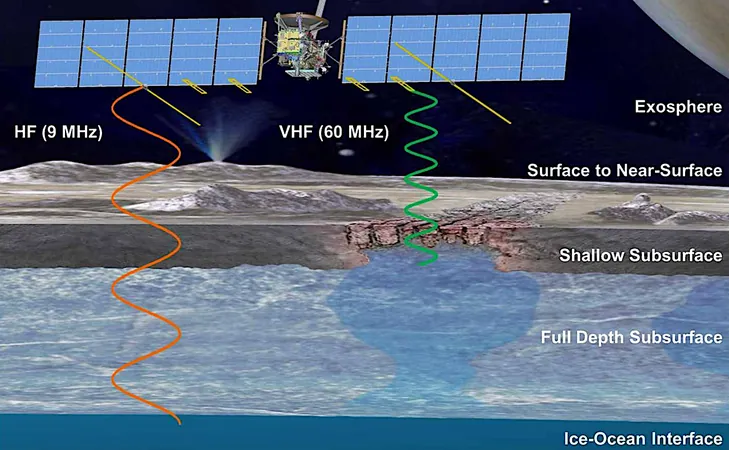
Unveiling Europa: The Revolutionary REASON Radar Set to Transform Our Understanding of Jupiter’s Icy Moon
2024-09-22
Author: Jia
Introduction
The groundbreaking Radar for Europa Assessment and Sounding: Ocean to Near-surface, commonly known as REASON, is a state-of-the-art dual-frequency ice-penetrating radar system, operating at frequencies of 9 and 60 MHz. This innovative technology is an integral component of NASA's ambitious Europa Clipper mission, designed to explore the mysterious icy moon Europa, one of the most intriguing bodies in our solar system.
Objectives of REASON
REASON aims to solve critical questions about Europa's environment. It will test pivotal hypotheses: first, whether the thick ice shell of Europa conceals a global ocean of liquid water beneath it; second, if this ice shell is influenced by tidal flexing due to gravitational interactions with Jupiter; and third, how the moon's exosphere, surface ice, and subsurface ocean might facilitate material exchange necessary to support life.
Mapping and Measurements
By meticulously mapping the distribution of believed non-ice substances, such as brines and salts within the ice, REASON will look for the elusive ice-ocean boundary, characterize the global structure of the ice shell, and measure the effects of tidal forces on Europa. This will create a multidimensional view of this enigmatic world, contributing significantly to our understanding of extraterrestrial oceans and their potential for habitability.
Advanced Radar Techniques
Employing a suite of advanced radar measurement techniques, including altimetry, reflectometry, sounding, interferometry, plasma characterization, and ranging, REASON stands out as the first ice-penetrating radar designed specifically for exploring the outer solar system. This pioneering instrument builds on decades of radar research conducted on Earth, the Moon, and Mars.
Ensuring Data Robustness
The development of REASON also includes novel strategies for assessing measurement quality, considering uncertainties inherent in the icy moon’s environment that could influence radar performance. This approach is crucial for ensuring data robustness, which will be essential in interpreting the extensive data collected during the mission.
Conclusion
As the Europa Clipper mission advances, REASON promises to unlock unprecedented insights into Europa’s subsurface characteristics, potentially confirming whether it is a habitable world. Coupled with other sophisticated instruments aboard the Clipper, REASON will revolutionize our knowledge of the icy moon and its capacity to harbor life.
Final Thoughts
Stay tuned, as the mission promises to change everything we thought we knew about one of the solar system's most fascinating moons!




 Brasil (PT)
Brasil (PT)
 Canada (EN)
Canada (EN)
 Chile (ES)
Chile (ES)
 Česko (CS)
Česko (CS)
 대한민국 (KO)
대한민국 (KO)
 España (ES)
España (ES)
 France (FR)
France (FR)
 Hong Kong (EN)
Hong Kong (EN)
 Italia (IT)
Italia (IT)
 日本 (JA)
日本 (JA)
 Magyarország (HU)
Magyarország (HU)
 Norge (NO)
Norge (NO)
 Polska (PL)
Polska (PL)
 Schweiz (DE)
Schweiz (DE)
 Singapore (EN)
Singapore (EN)
 Sverige (SV)
Sverige (SV)
 Suomi (FI)
Suomi (FI)
 Türkiye (TR)
Türkiye (TR)
 الإمارات العربية المتحدة (AR)
الإمارات العربية المتحدة (AR)